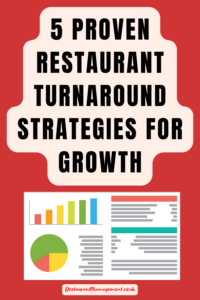Restaurant Turnaround Strategies
Many restaurants struggle to make it past their first few years – that’s no secret, and plenty of studies back it up. You’re not alone in this. But hitting tough times doesn’t mean the end of the road. Struggles don’t have to equal failure. With the right changes and the right restaurant turnaround strategies, a restaurant can reinvent itself, bounce back stronger, and even come out more successful than before.
If you’re reading this, chances are you – or someone you know – has felt the sting of empty tables, rising costs, or bad reviews. Don’t lose hope. This guide will walk you through why restaurants fail, how to spot danger signs, and the exact turnaround strategies that can save a business on the brink.

Why Restaurants Fail: The Hidden Traps Owners Overlook
Running a restaurant isn’t just about cooking great food. It’s about balancing finances, leading people, and keeping customers excited – all at once. According to studies, approximately 60% of restaurants fail within their first year, and 80% shut down within five years
The reasons aren’t always obvious, but they tend to repeat themselves.
Here are the biggest culprits:
Poor financial management: Many owners overspend on flashy décor or oversized menus without calculating return on investment.
Location – No clear target market: Opening an upscale restaurant in a college town where students crave cheap food is a recipe for disaster.
Inconsistent quality: You might win customers once, but repeat visits require reliable food and service.
Weak marketing: In the digital age, believing “good food sells itself” is business suicide.
Operational inefficiencies: From untrained staff to chaotic kitchens, small cracks quickly widen.
What’s striking is that most of these failures are preventable.
Spotting the Warning Signs Early
Failure doesn’t strike overnight. It creeps in, showing itself in small but noticeable ways. As an owner, you play a crucial role in preventing this from happening. You need to become a detective – constantly scanning for red flags. Being alert and taking action can make a big difference.
Ask yourself:
Have sales dipped consistently for three months or more?
Are bills piling up while cash flow shrinks?
Are customer reviews sliding downward?
Do you see familiar faces less often, meaning regulars are leaving?
Is staff morale low, with turnover increasing?
If several of these sound familiar, your restaurant may already be on shaky ground. But here’s the truth: spotting the problem early gives you time to act.

Honest Assessment Of Your Restaurant Turnaround Strategies
When your restaurant faces challenges, it can be easy to deny the problem. Many owners say, “It’s just a slow season,” while more serious issues could be happening. Ignoring these issues will not help. It’s essential to examine every part of your business.
Financial Review: Examine profit-and-loss statements. Where is money leaking – food costs, rent, or payroll?
Customer Feedback: Study online reviews and in-person comments. Do people complain about service speed, portion size, or ambience?
Competitor Analysis: Look at what nearby restaurants offer. Are they more affordable, trendy, or better marketed?
What is the 30/30/30/10 rule for restaurants?
The 30/30/30/10 rule is a simple financial guideline for restaurant owners. It helps you manage costs and stay profitable. According to this rule, you should divide your restaurant revenue like this:
30% to food costs (ingredients, kitchen supplies)
30% to labour costs (wages, benefits, training)
30% to overheads (rent, utilities, marketing, insurance)
10% to profit margin
This framework helps keep your expenses balanced and ensures you’re actually earning a profit, rather than just covering bills. Many successful restaurateurs swear by it because it provides a quick “health check” for restaurant finances.
A business owner I spoke with once, admitted that her pride stopped her from changing prices, even though competitors were offering better value. After she changed both the pricing and portion sizes, sales increased within a few months.
5 Proven Turnaround Strategies To Unleash Restaurant Success
Turnaround Strategy #1: Reinvent the Menu
Your menu is your brand identity. Yet, many restaurants overload it with too many options, overwhelming guests and slowing down kitchens.
A research article featured in the qsrmagazine.com revealed that simplified menus enhance both profitability and customer contentment. The reason? A reduced number of dishes leads to fresher ingredients, faster service, and a more defined brand identity.
Here’s how to fix yours:
Audit Performance: Track which products sell and which accumulate dust. Remove underperformers.
Focus on stars: focus on signature dishes that clients rave about.
Add seasonal specials: Rotating products keeps customers interested and reduces food waste.
Tell a story. Include local foods or cultural elements to give customers something to speak about.
For example, a farm-to-table café lowered its menu from 45 to 20 items while adding seasonal specials made with local products from surrounding farms. Within six months, profits increased by 25%, and social media chatter surged.
Guaranteed: The 7 Most Profitable Restaurant Foods To Skyrocket Your Profits
Turnaround Strategy #2: Rebuild Team Culture
Restaurants live or die by their staff. You can have the best menu in the world, but if servers are grumpy or the kitchen is chaotic, customers won’t return.
The National Restaurant Association reports that the yearly turnover rate in the restaurant business exceeds 70%, which is significantly higher than the average for other industries.
Training and retaining staff is not optional – it’s a matter of survival.
To rebuild culture:
Prioritise training: Staff should be comfortable with the menu and fundamental customer service skills.
Communicate clearly. Weekly team meetings help to keep everyone on the same page.
Celebrate successes: Recognise top performers to promote morale.
Model leadership: Owners who demonstrate respect and make a genuine effort inspire loyalty.
I previously worked at a casual dining restaurant where employees feared coming in because the manager screamed commands all day. When the leadership adopted a more collaborative approach, service improved almost immediately.
Turnaround Strategy #3: Mastering Restaurant Marketing
Even the best-kept secret restaurant cannot survive if no one knows it exists. In today’s world, marketing is not an option; it is your lifeline.
According to BrightLocal, 87% of shoppers read online reviews before visiting a local business.
Practical marketing steps:
Optimise your Google Business Profile by updating hours, menus, and uploading new photographs.
Social media engagement: Share behind-the-scenes stories, daily offers, and consumer testimonials to foster a sense of community.
Email campaigns: Make personalised offers to past consumers.
Encourage reviews by politely asking delighted customers to provide favourable comments.
Case in point: A struggling taco shop in the US began posting behind-the-scenes TikToks about their empty shop. Within a short space of time, the videos went viral, foot traffic doubled, and the once-empty shop became a must-visit destination.

Turnaround Strategy #4: Fix the Finances
Let’s be blunt: many restaurants don’t close because of bad food – they close because of bad mathematics. If you don’t control costs, your business will bleed out.
Here’s how to stabilise finances:
Negotiate with suppliers: Bundle orders to secure discounts or explore new vendors.
Control food waste: Serving smaller portions reduces costs without compromising customer satisfaction.
Renegotiate rent: Many landlords prefer reduced rent to losing a tenant.
Track numbers daily. Do not wait for monthly reports; regular monitoring prevents surprises.
One pizza owner discovered that he was losing £2,500 per month because his staff were throwing out unsold dough. He switched to just-in-time ordering and prep technique and converted losses into gains in just a few weeks.
Turnaround Strategy #5: Redefining Customer Experience
In every restaurant business, the food is vital, but it’s the experience that keeps customers coming back. Consider your most recent favourite meal experience. It wasn’t simply the food, but also the ambience, service, and other details.
Enhance customer experience by:
Refreshing ambience: Small upgrades, such as lighting, music, or seating layouts, can create a significant impact.
Improving speed: No one enjoys waiting forever. Streamline kitchen and service processes.
Adding personal touches: Remember regulars by name or note birthdays in your system.
Marketing expert Seth Godin once said, “People do not buy goods and services. They buy relations, stories, and magic.” Restaurants that deliver memorable experiences turn customers into advocates.
Case Study: From Near-Closure to Local Hotspot
Let me share a real turnaround story.
A family-owned Italian restaurant was rapidly losing customers. Sales had dropped by 40%, staff turnover was significant, and online reviews complained about “boring food” and “slow service.” Instead of giving up, the owner acted aggressively.
Reduced the menu from 80 to 25 targeted dishes.
He hired a new chef to provide authentic regional Italian cuisine.
He introduced a redesign of Instagram’s campaign that includes behind-the-scenes kitchen videos.
He developed a loyalty program that offered a complimentary tenth meal.
Within eight months:
Revenue increased by 65%.
Employee turnover dramatically decreased.
Experiences show that failure can be a critical turning point, rather than the conclusion of a journey.
RELATED ARTICLE
Most Profitable Restaurant Foods
Your Restaurant Is About To Fail
Final Insights: Understanding Failure
Running a restaurant is difficult, and it’s normal to feel embarrassed when anything goes wrong. Step back and assess the issue. Keep your passion alive and believe in your restaurant turnaround strategies. Consider these problems as opportunities to learn and improve. They can help you get closer to your business goals. This is not the end of your culinary adventure; it is only a step towards improving your talents and achieving your objectives.
You Moving forward requires a bold approach:
– Acknowledge what is not functioning successfully.
– Consider revamping your menu to meet customer preferences and trends.
Rebuild your team.
Markets like your survival depend on it – because it does.
Focus relentlessly on customer experience.
Failure isn’t the opposite of success; it’s part of the journey there. If you treat setbacks as feedback, you’ll come back smarter, stronger, and ready to create the restaurant your community loves.
So, here’s the big question: are you ready to write your own comeback story?

FAQ’s
What are the seven proven restaurant turnaround strategies and steps?
While turnaround strategies vary depending on the business, most experts agree on these seven core steps for saving a failing restaurant or company:
Recognise the crisis early – Don’t deny the warning signs.
Conduct a thorough assessment – Identify what’s broken: finances, service, or market positioning.
Stabilise finances: Control costs, renegotiate contracts, and improve cash flow.
Restructure operations: To improve how you work. Make your processes easier, reduce waste, and increase productivity. This will help you use our resources better and create a more efficient workplace.
Rebuild the team: To boost team performance, you need to train, motivate, and keep your staff. Investing in training programs gives employees the skills and knowledge they need. Also, creating a motivating work environment increases job satisfaction and productivity. Ultimately, employing effective strategies to retain employees ensures a stable and committed team.
Reposition in the market: To reposition your brand in the market, start by refreshing your branding elements. Next, refine your menu offerings, implement new marketing strategies to improve your visibility and attract your target audience, leading to success.
Measure and adjust: To perform at their best, businesses must measure progress and make adjustments when needed. By tracking results regularly, they can continually improve, which in turn boosts overall effectiveness.
Following these steps not only saves a business but can also make it stronger than before.
What are the 5-step processes for turnaround management?
The 5-step turnaround management process offers a focused roadmap for leaders facing decline:
Situation Analysis: Evaluate the current financial health of your restaurant, understand customer perceptions and satisfaction levels, and identify any operational challenges that may be impacting performance.
Emergency Action: In an emergency, quick action is crucial to stabilise the situation. You can achieve this by taking immediate steps, like cutting unnecessary expenses and boosting sales efforts. These actions can enhance financial health and support the organisation’s sustainability.
Stakeholder Engagement: To ensure a project’s success, it’s important to engage effectively with key stakeholders. This involves building trust and gaining support from various groups, including staff, investors, suppliers, and customers. By fostering strong relationships with these stakeholders, organisations can enhance teamwork and achieve better results.
Strategic Redirection: The plan should involve creating a new vision for the organisation, updating the menu to better align with customer preferences, and rebranding to offer a fresh perspective. These steps are essential for responding to market changes and improving the brand’s relevance.
Implementation & Monitoring: Implement the proposed changes, review the results, and adjust your strategies to ensure they work as effectively as possible.
This structured process gives owners clarity in times of uncertainty and prevents panic-driven decisions.
What are the 4 P’s of restaurant marketing?
The 4 P’s of restaurant marketing – adapted from traditional marketing principles—are essential for attracting and retaining customers:
Product – Your menu, food quality, and the overall dining experience.
Price – Competitive pricing, perceived value, and innovative promotions.
Place – Your restaurant’s location, atmosphere, and online presence (delivery apps included).
Promotion – Marketing efforts like social media, email campaigns, events, and customer loyalty programs.
When all four align, your restaurant becomes more than just a place to eat—it becomes a brand customers connect with.
Top 14 Reasons Your Restaurant Is About To Fail Within The First Year


